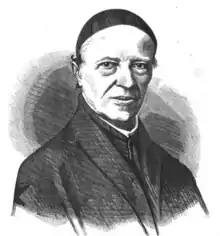Antonio Bresciani (writer)
Antonio Bresciani (24 July 1798 – 14 March 1862) was an Italian Jesuit priest and writer, mostly known for his reactionary diatribes against liberalism and the Risorgimento.[1] The Marxist intellectual Antonio Gramsci used the terms "Brescianism" and "Father Bresciani's progeny" to describe literature of a conservative and populist bent.[2]
Antonio Bresciani | |
|---|---|
 | |
| Born | 24 July 1798 Ala, Trentino |
| Died | 14 March 1862 Rome |
Anti-Semite
Bresciani's theories are characteristic of the "paranoid style" in politics, positing a Satanic conspiracy among secret societies and Jews to undermine the Christian order.[3] Bresciani's highly popular novel 1850 novel L'Ebreo di Verona (The Jew of Verona) shaped religious anti-Semitism for decades in Italy, as did his work for La Civiltà Cattolica, which he helped launch.[4][5]
Selected Works
- Vita del giovane egiziano Abulcher Bisciarah, 1838
- L'Ebreo di Verona, (1850)
- Lorenzo, o il coscritto - racconto ligure (1856)
- Della Repubblica romana (appendice de L'Ebreo di Verona), 1858
- Ubaldo e Irene - racconti (1858)
- La contessa Matilde di Canossa e Isabella di Groniga (1858)
- La casa di ghiaccio o il cacciatore di Vincennes (1861)
- Olderico, ovvero Il zuavo pontificio, racconto del 1860 (1862)
- Lionello o delle Società Segrete (seguito de La Repubblica romana)
- L'assedio di Ancona (incompiuto)
References
- Lang, A. (2008). Converting a Nation: A Modern Inquisition and the Unification of Italy. Springer. pp. 106–109.
- Fluck, Winfried (2003). Theories of American Culture, Theories of American Studies. Gunter Narr Verlag. p. 146.
- Dickie, John (2017). "Antonio Bresciani and the sects: conspiracy myths in an intransigent Catholic response to the Risorgimento". Modern Italy. 22 (1): 19–34.
- Brustein, William (2003). Roots of Hate: Anti-Semitism in Europe Before the Holocaust. Cambridge University Press. p. 76.
- Feinstein, Wiley (2003). The Civilization of the Holocaust in Italy: Poets, Artists, Saints, Anti-semites. Fairleigh Dickinson Univ Press. pp. 151–152.
This article is issued from Wikipedia. The text is licensed under Creative Commons - Attribution - Sharealike. Additional terms may apply for the media files.